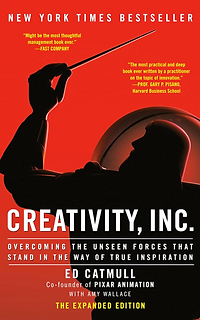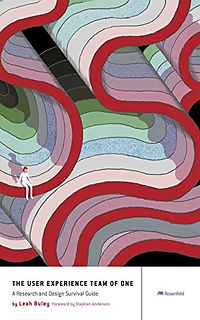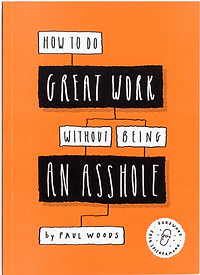Creativity, Inc.: Overcoming the Unseen Forces That Stand in the Way of True Inspiration
12 SEPT 2024

Test. Fail. Iterate. It’s not just a process—it’s something we need to enjoy. Failure isn’t a setback; it’s a lesson. Write down what didn’t work. Learn from it. Move forward.
Ed Catmull: "the person who can’t change is dangerous." That stuck with me. True growth comes from expecting the unexpected and staying flexible—even in those “two-inches-from-disaster” moments. That kind of humility—knowing things will go wrong—is powerful. Thinking otherwise makes us blind to risk. As a leader, my goal isn’t to help my team avoid every mistake. It’s to help them become confident problem-solvers. That’s what drives great products and strong teams.
"You don’t want people walking on egg shelLs. You want brave, workers not scared to make a mistake, but when they do make that mistake they have the guts and the brains to solve the problem."
— Ed Catmull
Easy read for upcoming designers. Tons of good reminders to help understand web usability, and user experience with simple illustrations, and concepts that kept me engaged. Designing is a complicated process and there is no — one right answer to most usability questions. However Krug lists a few key principles that can help, some of the principles I took away were — usability is about people and how they understand and use something. Technology often changes quickly, but people change very slowly. When we design a site, my job is to get rid of the question marks. A great analogy from this book: think of the user going on your site like viewing a billboard going by at 80 miles an hour! Don't make them think!
Don’t make me think
04 MAY 2020

“When we’re creating sites, we act as though people are going to pore over each page, reading all of our carefully crafted text, figuring out how we’ve organized things, and weighing their options before deciding which link to click.”
— Steve Krug
The UX Team of One: A Research and Design Survival Guide
19 AUG 2020

This will be a great read for people just starting out, OR well affirmed in UX. You don't need to be a team of one to apply the practical principles of this book. My key takeaways was the importance of research and also how to evangelise the UX framework to key decision makers in your respective projects. Buley states that the "conversation is key." This challenged me to become a UX ambassador, preaching the benefits of UX. We must be ready to educate others on the value of a strong UX practice — this will create a better playing field for projects when everyone is on board.
“Employers expect UX practitioners to be able to back up their recommendations and show their work. Employers also might expect the user experience practitioner to challenge and persuade others in the organization to adopt new approaches. UX teams of one sometimes have to be diplomatic, informed, and well-meaning meddlers.”
How to learn how to read
05 OCT 2020

I had just finished Jim Kwik's master class on How To Learn How To Read. Setting a goal for myself to read a book every month. We'll see how that goes. Note to self: capturing notes and creating note are two different things. When reading a book ask yourself, How can you use this book, of what you are reading. Why must you use this, and when will you use this? Also using FAST when you want to learn something. The act if speed learning, learning in half the time.
F • Forget everything you've learnt on the topic. Be a kid.
A • Active, take notes, ask questions
S • State information + emotion becomes long term memory. Make sure you in a good state and not tired. Learn to use your emotions when learning because learning is state dependent. Set the state, set what you feel. So the environment matches you.
T • Teach it to someone else. If you can teach it to someone, you are learning it twice over.
"Trade your cleverness with bewilderedness." - Jim Kwik
Dare to think differently
10 JAN 2021
A quote I learnt from my time as a student at Shillington College, that has stuck with me till now. Reading this, again and again, reminds me to venture out of my comfort zone.
"Here’s to the crazy ones. The misfits. The rebels. The troublemakers. The round pegs in the square holes. The ones who see things differently. They’re not fond of the rules. And they have no respect for the status quo. You can praise them, disagree with them, quote them, disbelieve them, glorify them or vilify them. About the only thing you can’t do is ignore them. Because they change things.
~ Rob Siltanen
design of everyday things
12 JAN 2021
An awesome read recommended by a senior designer I was working with. You really do look at door knobs differently after this book. A good reminder that Human-centered design is used to make products for the user, and helps users learn how to use a product. A take-away I will always remember from this read is the importance of giving manufacturers feedback. Users run into trouble with products all the time, prime example when you make a mistake. Don’t blame yourself, as chances are you’re not the only one who’s made that error. It is most likely 'bad design,' and you need to do your part by letting the designers know that there is a problem so they can iterate or improve the product.

“It is easy to design devices that work well when everything goes as planned. The hard and necessary part of design is to make things work well even when things do not go as planned”
~ Don Norman
design driven growth
15 JAN 2021
Short easy read with case studies that show the importance of following through with products/websites is just as important as the idea and process to design them. Most of the case studies describe focusing on small improvements for your users, cutting out the fluff that doesn't add value. That's simplifying your Value Propositions —
start with a small number of features but do them well. Molly outlines 'conversions' as the eventual outcome of small interactions and user journeys that take place over time. The more you have the better right? She also explains ways to improve and grow your products — such as AB testing, simple changes in banner images, UI changes, and incorporating secondary call to actions.
Most designers don't build experiences that allow for smaller, incremental engagements and conversions. But this is actually a key to capturing more conversions over time.

"No single department or job title, should own growth, as it is the optimal and natural intersection of the full companies work.... A good user experience, is one that drives growth and retention."
~ Molly Norris Walker
Distractions are when you give time to low importance, undue attention. I've been learning to be mindful of my priorities. Every night I've been trying to write down what I need to focus on the next day. I find this better than clarifying my tasks in the morning — before I sit down to work. It helps me jump straight into it knowing that I prepared beforehand.
productivity and focus
16 JAN 2021
"Doing just a little bit during the time we have available puts you that much further ahead than if you took no action at all.”
– Byron Pulsifer
The senior designer at Newpath, my colleague and friend recommended me a few books to further my UX practice. We had a discussion on me taking more of a client facing role and this book is what helped him understand the nuances of managing people and clients. This read really helped set a good foundation to push me in a new direction. Some key takeaways I found from the book was:
1. I will leave my ego at home
2. I will be direct, respectful, and honest with my team and clients
3. I will give credit where credit is due
4. I will cancel meetings that waste time
5. I will do everything I can to ensure no one has to work late nights or weekends.
6. Keep meetings as short as humanly possible
7. When explaining things, provide clear visual examples
8. Clearly state the purpose of meetings.
HOW TO DO GREAT WORK WITHOUT BEING AN ASSHOLE
12 MAR 2021
"Remember the number one rule. Design is not art — you are not Picasso. You are not even George W. Bush painting in his basement. You are working for a commercial practice that has stakeholders, budgets, bosses, and deadlines. Keep this ingrained in your pysche for every client engagement."
– Paul Woods

It's been one chaotic year, but everything finally fell into place this week. I'm moving to London for the launch of a product I've been advising for. I've also started a new job with Outliant. An agency that wants me to take on more of a managing role; which will be a great opportunity for me. The new gig comes with new responsibilities that I'm excited for, different teams/projects around the world means I'll be working with all sorts of new designers. A new team. A new country. A new adventure.
moving to london
20 APR 2021
“Twenty years from now you will be more disappointed by the things that you didn’t do than by the ones you did so. So throw off the bowlines. Sail away from the safe harbor. Catch the trade winds in your sails. Explore. Dream. Discover.”
– Mark Twain
